Discover 20 hidden attractions, cool sights, and unusual things to do in Augusta (United States). Don't miss out on these must-see attractions: Morris Museum of Art, Fort Discovery, and James Brown Arena. Also, be sure to include Confederate Powderworks in your itinerary.
Below, you can find the list of the most amazing places you should visit in Augusta (Georgia).
Table of Contents
Morris Museum of Art
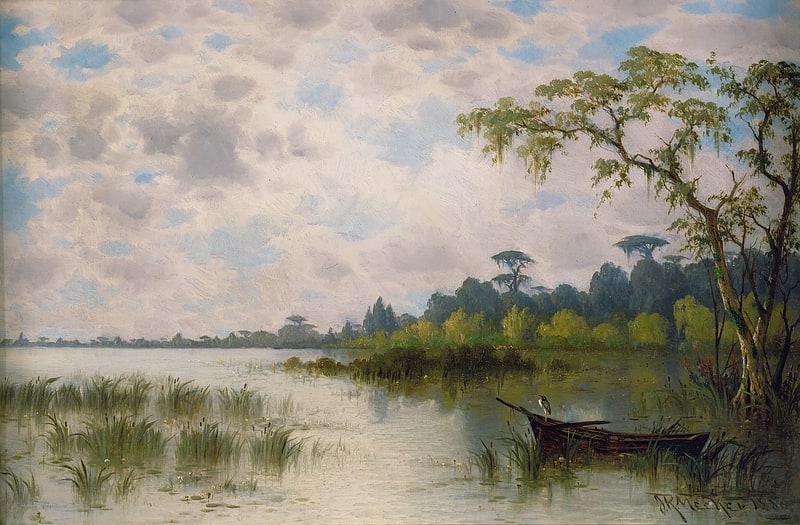
Museum in Augusta, Georgia. The Morris Museum of Art in Augusta, Georgia was established in 1985 as a non-profit foundation by William S. Morris III, publisher of The Augusta Chronicle, in memory of his parents, as the first museum dedicated to the collection and exhibition of art and artists of the American South.
In 1989, Morris bought 230 pictures for the museum from Southern art collector Robert P. Coggins, with Keith Claussen appointed museum director the following year. On September 26, 1992, "The Morris" opened to the public, attracting over 10,000 visitors in the first two months.
With more than 3,000 works in its permanent collection, the museum hosts changing exhibitions, educational programs, musical events, and hands-on art programs. The museum is located adjacent to Riverwalk Augusta and the Savannah River.[1]
Address: 1 10th St, 30901-0100 Augusta (Old City)
Fort Discovery
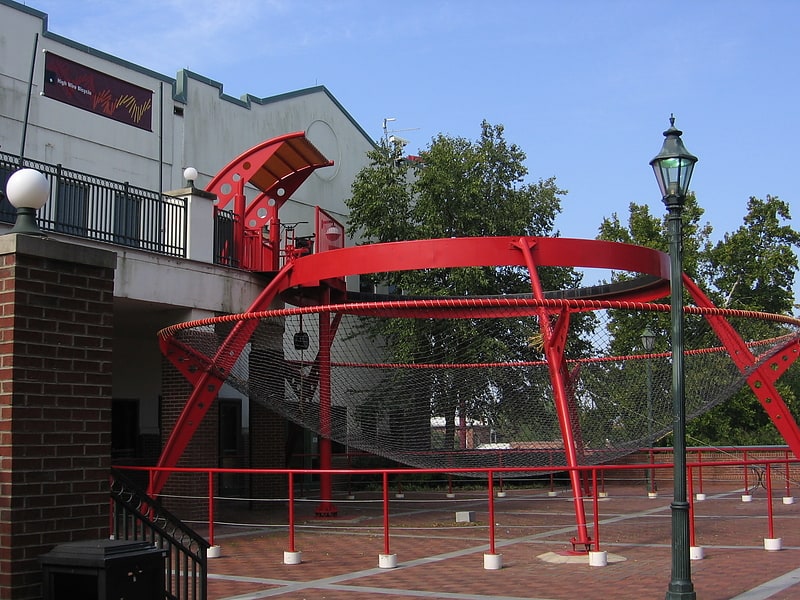
Museum in Augusta, Georgia. The National Science Center's Fort Discovery, generally known as Fort Discovery, was a 128,000-square-foot, children's science exhibition center and museum located in downtown Augusta, Georgia, at Riverwalk Augusta. The museum was located in the former Shoppes at Port Royal, which operated from 1991 to 1994.
Fort Discovery featured over 250 hands-on exhibits that demonstrated various scientific concepts. It featured several rides such as a high-wire bicycle, the human gyroscope, and space moon walk, each demonstrating a fundamental concept of physics. The center opened in April 1997. In late 2003, the state cut off funds to the center and Fort Discovery was at danger of closing. In early 2004, the city and community funded Fort Discovery until January 2005, when the state started funding the center once more.
National Science Center relocated to Washington, D.C. after Fort Discovery closed permanently on December 31, 2010.
After Fort Discovery closed, Unisys purchased a portion of the building as its new center in Augusta.[2]
Address: One Seventh Stree, Augusta (Old City)
James Brown Arena

Arena in Augusta, Georgia. James Brown Arena is a multi-purpose complex located in Augusta, Georgia. It is managed by Spectra Experiences.
It features an 8,000-seat arena, renamed the James Brown Arena, in honor of musician James Brown on August 22, 2006. The complex also features a 2,800-seat theater, the William B. Bell Auditorium, and a 14,500-square-foot (1,350 m2) exhibit hall that opens into a 23,000-square-foot (2,100 m2) arena floor.
The James Brown Arena is the former home of the ECHL's Augusta Lynx from 1998–2008, the AF2's Augusta Stallions from 2000–2002, Augusta Spartans from 2006-2007, and the Southern Professional Hockey League's Augusta RiverHawks from 2010–2013.
The Arena hosted UFC 11.
The arena has also hosted many concerts and pro wrestling events, including ECW's December to Dismember in 2006. Many bands have played the arena including Van Halen, Rush, Heart, Bob Seger, REO Speedwagon, KISS, Bon Jovi, Molly Hatchet, John Cougar, Kansas, Charlie Daniels Band, Alabama, Blackfoot, Mother's Finest, Ratt, Mötley Crüe, Def Leppard, Cheap Trick, Marshall Tucker Band, and Loverboy.
The center-hung Fair Play scoreboard dates to the arena's opening in 1980, and in recent years has been joined by additional scoreboards and a Trans-Lux LED video display which can be found at each end of the arena.[3]
Address: 712 Telfair St, 30901-2327 Augusta (Old City)
Confederate Powderworks
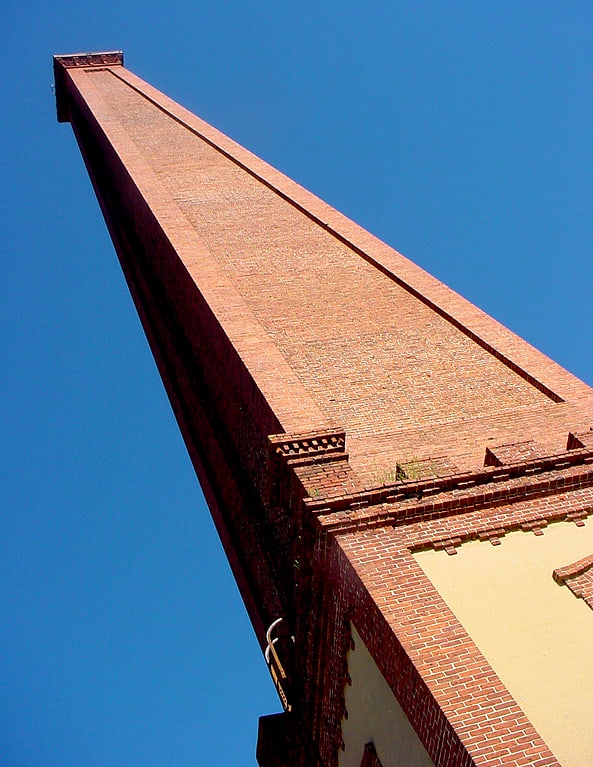
The Confederate Powderworks was a gunpowder factory during the American Civil War, the only permanent structures completed by the Confederate States of America. Colonel George Washington Rains chose the old United States Arsenal site between the Canal and Savannah River in Augusta, Georgia, as a secure inland location with good rail and water connections.[4]
Address: 1717 Goodrich Street, Augusta (Old City)
Saint Paul's Church
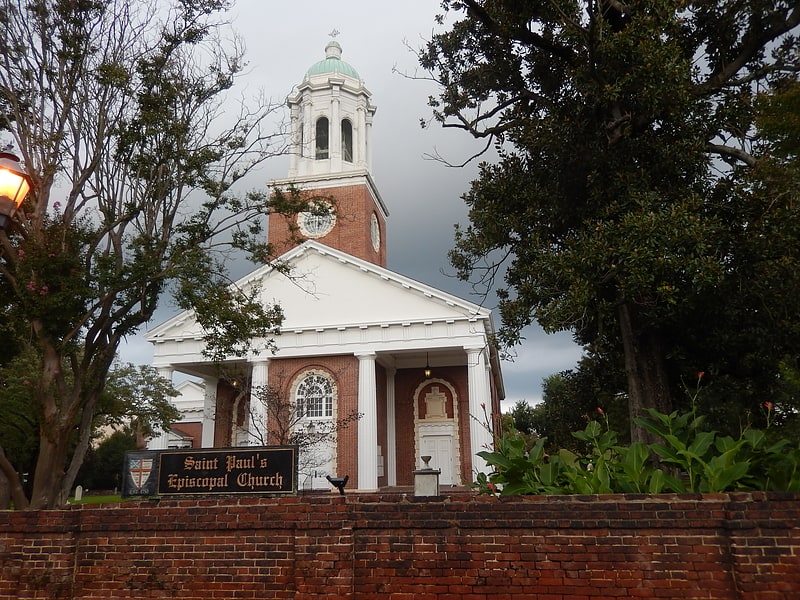
Church in Augusta, Georgia. Saint Paul's Church is a historic Episcopal church in downtown Augusta, Georgia, adjacent to Riverwalk Augusta. A member of the Episcopal Diocese of Georgia, Saint Paul's conducts its worship services using the 1979 Book of Common Prayer. The church, located on the corner of 6th and Reynolds Streets, is the oldest church congregation in Augusta. It was established in 1750 by the Church of England at the site of Fort Augusta. There have been five churches on the site. The current church building, which combines features of Federal architecture with those of the Georgian and Greek Revival styles, was designed by Henry Ten Eyck Wendell and dedicated in 1920. It can seat up to 600 people.
Saint Paul's is an active congregation. Its three Sunday worship services at 8 a.m. 11 a.m. and 5:30 p.m. include celebration of the Lord's Supper, known in the Episcopal Church as the Holy Eucharist. The 8 am service (no music) uses Rite I of the 1979 Book of Common Prayer. The 11 am choral service uses Rite II of the 1979 Book of Common Prayer. The 5:30 Celtic Communion is a meditative healing service that includes quiet music by local musicians. The nave is open to the public for private prayer from 9 a.m. to 3 p.m, Monday through Thursday, and 9 a.m. to noon, Friday. A guestbook and historical brochures are available in the narthex. For additional information on the activities and history of Saint Paul's Church, see the church website at http:www.saintpauls.org/
Christian formation classes for all ages are held each Sunday from 9:30 to 10:30 a.m. Nursery care is offered from 9 a.m. to 12:30 p.m. The 11 a.m. service is broadcast on local radio at WGAC 580 AM Radio and WGAC 95.1 FM Radio. Listeners can hear the service on-line at http:wgac.com/listen-live/
Saint Paul's has a long history of service and hospitality to the wider Augusta community and to the Episcopal Diocese of Georgia. It is a member of Downtown Cooperative Church Ministries, a consortium of downtown Augusta churches which provides food, medical, housing, and financial assistance to those with limited means. The Saint Paul's Outreach Committee raises funds to support local charities. In cooperation with Golden Harvest Food Bank, the parish's bi-monthly Manna Pantry program provides nutritionally healthy foods to local residents dealing with food insecurity.
Through its River Room event facility, Saint Paul's provides a site for a wide range of community activities, including wedding receptions, concerts, school proms, training seminars, fund-raising galas, and meetings of local community and business organizations. Saint Paul's also hosts athletes competing in the Augusta Ironman Triathlon each September, providing a pasta dinner for competitors, a gear drop for the swim event, drinks and snacks for participants and volunteers, and a quiet space for spiritual preparation.
Since 1988, Saint Paul's has hosted Tuesday's Music Live, the nation's largest luncheon concert series, which brings nationally and internationally known musicians to perform for local audiences. From September to May, the 13-concert series annually attracts roughly 5,000 attendees with a variety of classical, jazz, soft pop, and choral performers. The free concerts are supported by a mix of business and foundation grants and individual donations.[5]
Address: 605 Reynolds St, 30901 Augusta (Old City)
Lake Olmstead Stadium

Stadium in Augusta, Georgia. Lake Olmstead Stadium is a baseball park in Augusta, Georgia, United States. It was built between the 1994 and 1995 seasons to replace Heaton Stadium on the same site and can hold 4,822 people. The stadium also serves as an outdoor-arena style event venue.
Lake Olmstead Stadium was primarily used as the home field of the Augusta GreenJackets of the Class A South Atlantic League from 1995 to 2017, after which the GreenJackets moved to the new SRP Park across the Savannah River in North Augusta, South Carolina, in 2018.
Lake Olmstead Stadium was the home field of the Augusta University Jaguars baseball team for most of their games from 2009 to 2013 and all of their games from 2014 to 2018; however, the team elected to return to Jaguar Field on the Forest Hills campus full-time starting in the 2019 season.[6]
Address: 78 Milledge Rd, 30904-3022 Augusta (Old City)
Woodrow Wilson Boyhood Home
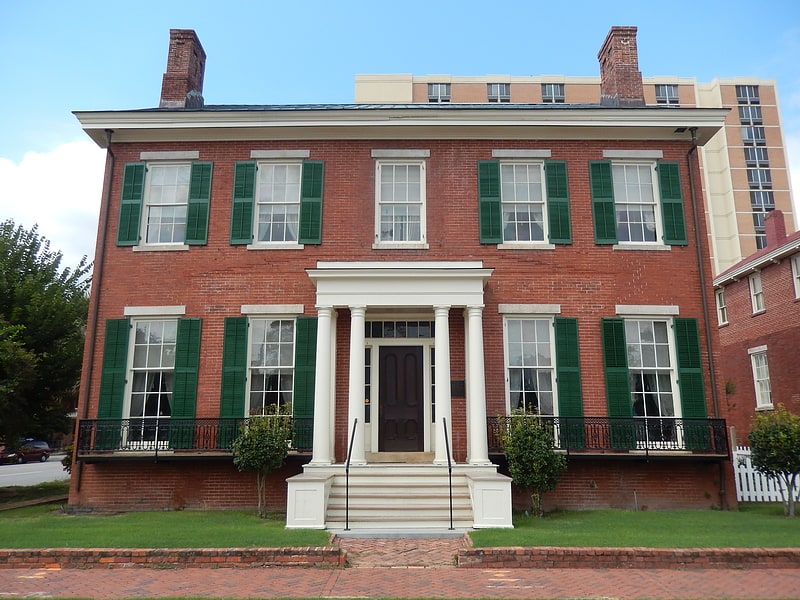
Museum in Augusta, Georgia. The Woodrow Wilson Boyhood Home is a historic house museum at 419 7th Street in Augusta, Georgia. Built in 1859, it was a childhood home of Woodrow Wilson, the 28th president of the United States and proponent of the League of Nations. The house is owned and operated by Historic Augusta, Inc. and was designated a National Historic Landmark on October 6, 2008.[7]
Address: 419 7th St, 30901 Augusta (Old City)
Augusta Riverwalk
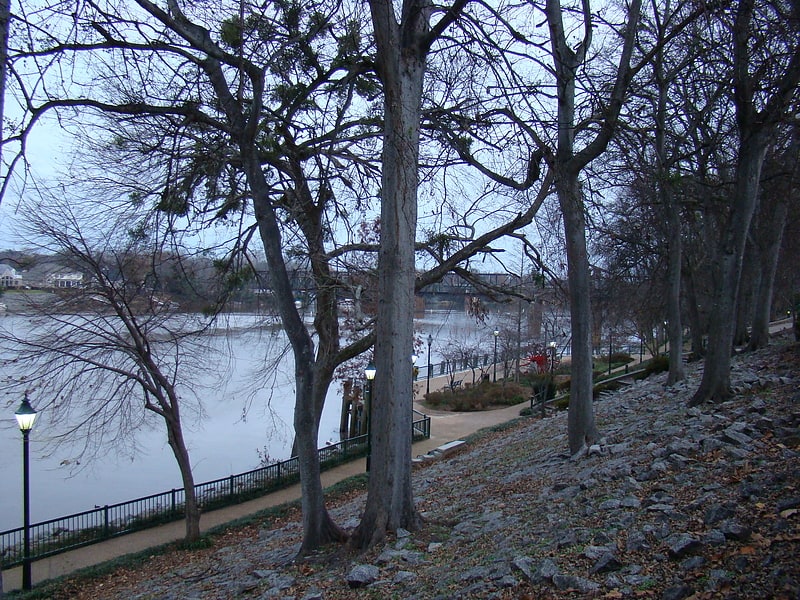
Riverwalk Augusta is a city park along the Savannah River in downtown Augusta, in the U.S. state of Georgia. The park is alongside and on top of Augusta's levee. It extends from the 13th Street Bridge to the Gordon Highway bridge. Sites along the Riverwalk include St. Paul's Episcopal Church, Georgia Cyber Center, and the Morris Museum of Art.[8]
Augusta Museum of History
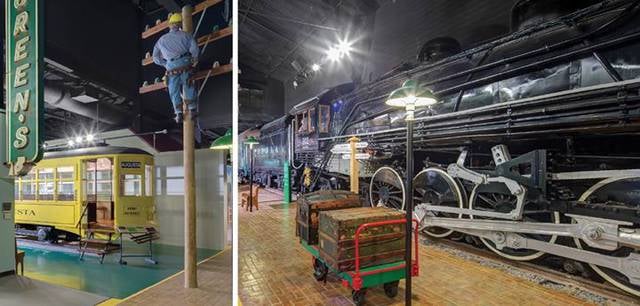
Museum in Augusta, Georgia. The Augusta Museum of History is a history museum located in Augusta, Georgia, U.S. The museum was founded in 1937 to preserve and share the history of Augusta and its surrounding area. On display are numerous artifacts, images, and dioramas that showcase the broad spectrum of the region’s history. The Museum of History is the only Museum in the CSRA accredited by the American Alliance of Museums.[9]
Address: 560 Reynolds St, 30901-1430 Augusta (Old City)
Augusta Cotton Exchange Building
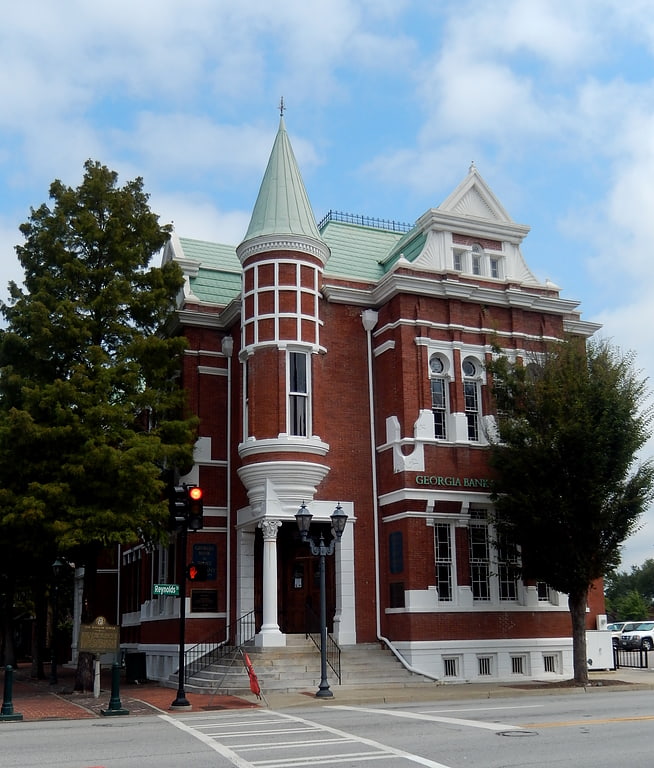
Building in Augusta, Georgia. Augusta Cotton Exchange Building is a historic building in Augusta, Georgia. It was designed by Enoch William Brown and built in the mid-1880s during a cotton boom. The structure includes ornate details and ironwork and is considered High Victorian architecture. Materials for its construction were supplied locally by Charles F. Lombard's foundry. It was added to the National Register of Historic Places on July 20, 1978. It is located on Reynolds Street.
The exchange was organized for the cotton trade. It housed brokers and a trading floor. Women were excluded and off hours cockfights and Saturday football meetups took place.
The building is part of the Augusta Downtown Historic District and Augusta Canal National Monument Heritage Area. Bill Moore of Aiken, South Carolina purchased and restored the building in 1988. The building has been used by the Augusta Metropolitan Convention and Visitors Bureau as a Welcome Center and is now a branch of South State Bank.[10]
Address: 816 Cotton Lane, Augusta (Old City)
Enterprise Mill
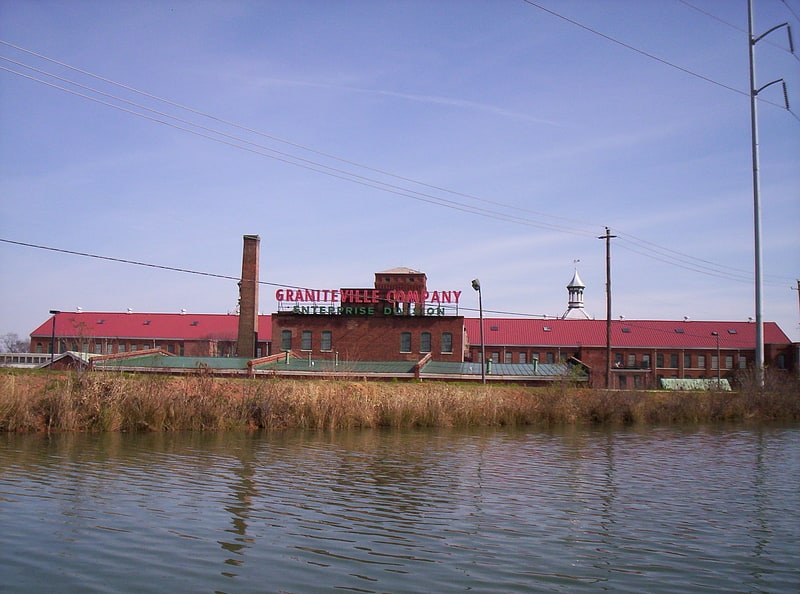
The Enterprise Mill is a historical residential and office complex along the Augusta Canal in Augusta, Georgia. Enterprise is located at the corner of Greene Street and 15th Street.[11]
Address: 1450 Greene St, Augusta (Old City)
Sacred Heart Cultural Center
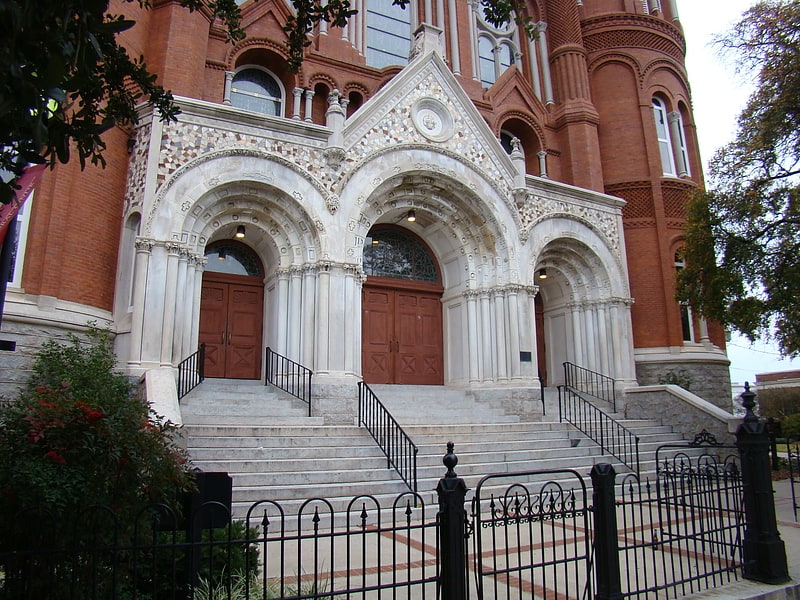
Cultural center in Augusta, Georgia. The Sacred Heart Cultural Center, known also as Sacred Heart Catholic Church, is an events center and a former Roman Catholic Church located in Augusta, Georgia.[12]
Address: 1301 Greene St, 30901-1031 Augusta (Old City)
First Baptist Church
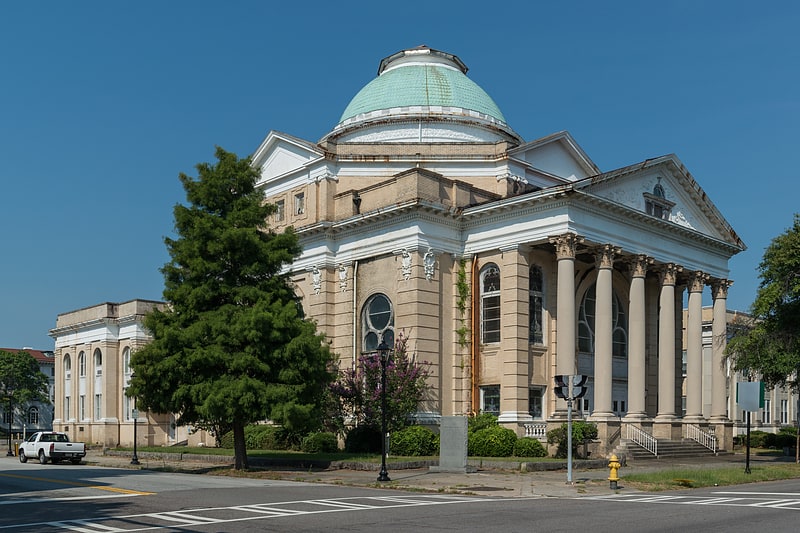
Baptist church in Augusta, Georgia. First Baptist Church of Augusta is a Southern Baptist church in Augusta, Georgia. The original location is now a historical site. The current church building is located on Walton Way.[13]
Meadow Garden
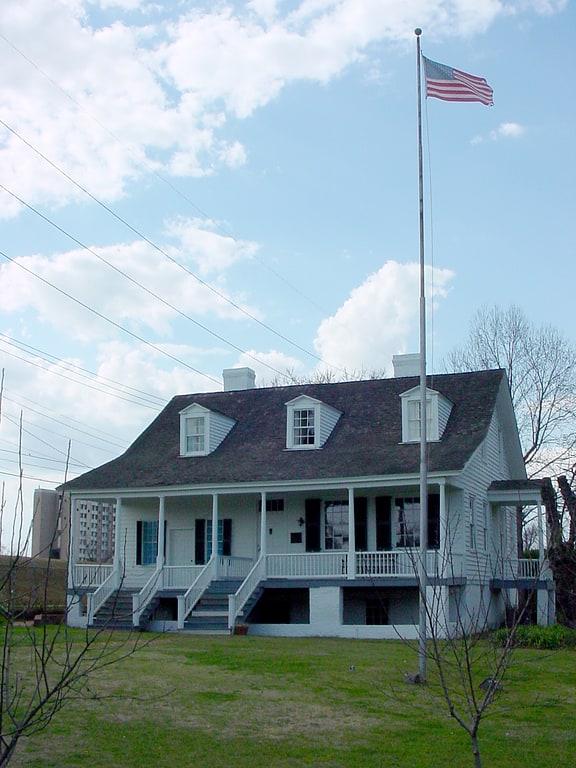
Historical landmark in Augusta, Georgia. Meadow Garden is a historic house museum at 1320 Independence Drive in Augusta, Georgia. It was a home of George Walton, one of Georgia's three signers of the U.S. Declaration of Independence, and later a governor of Georgia and a United States Senator. Meadow Garden was saved and established as a museum by the Daughters of the American Revolution in 1901. It was declared a National Historic Landmark in 1981.[14]
Address: 1320 Independence Dr, 30901-1038 Augusta (Old City)
Augusta Confederate Monument
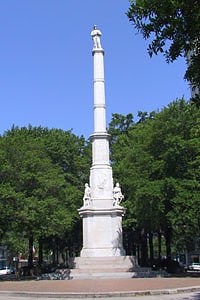
Monument in Augusta, Georgia. The Augusta Confederate Monument, also known as the Richmond County Confederate Monument, is located in the median of the 700 block of Broad Street in downtown Augusta, Georgia. The monument is seventy-six feet high on a granite base, topped by a shaft of Carrara marble. The monument was commissioned in 1875 by the Ladies Memorial Association of Augusta. It was designed by the architectural firm of VanGruder and Young of Philadelphia, built by the Markwalter firm of Augusta, carved by Antonio Fontana, and dedicated on October 31, 1878.
Around the base of the monument are the life size statues of four Southern generals in the American Civil War: Thomas R. R. Cobb, Stonewall Jackson, Robert E. Lee, and William H. T. Walker.[15]
Butt Memorial Bridge
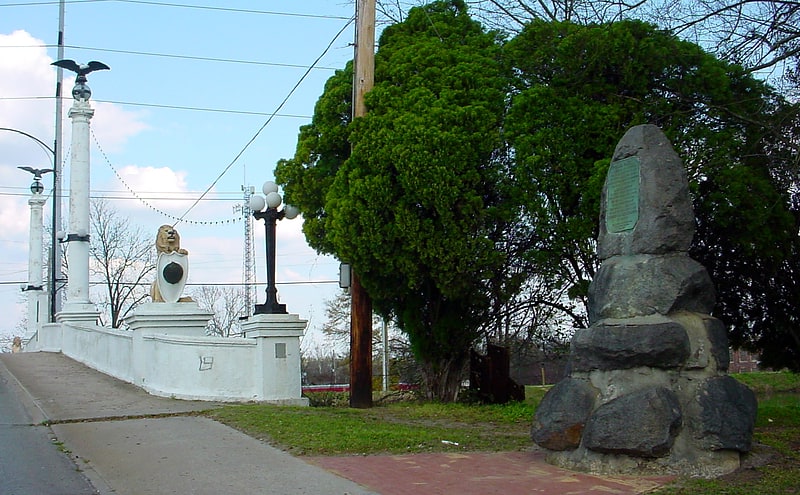
Bridge in Augusta, Georgia. The Butt Memorial Bridge is a road bridge in Augusta, Georgia that carries 15th Street over the Augusta Canal. It is dedicated to Major Archibald Willingham Butt, born in Augusta and a victim of the sinking of RMS Titanic. The bridge was erected in 1914 and dedicated by President William Howard Taft, a personal friend of Butt's. It is notable that the bridge was the first memorial erected to remember the Titanic disaster, and it stands today as the only memorial in Georgia dedicated to the disaster. The bridge is made of stone, featuring four pillars topped with bronze-banded globes placed over electric lights. Four lions with plaques adorn each side and end of the bridge, while lights are strung from one end of the bridge to the other. A memorial plaque is located on the center of the bridge, dedicated to Butt's memory.
The bridge was designed by William Henry Deacy, architect and Nisbet Wingfield, civil engineer. The bridge was fabricated by W. W. Leland Company.[16]
Address: 15th Street, Augusta (Old City)
Springfield Baptist Church
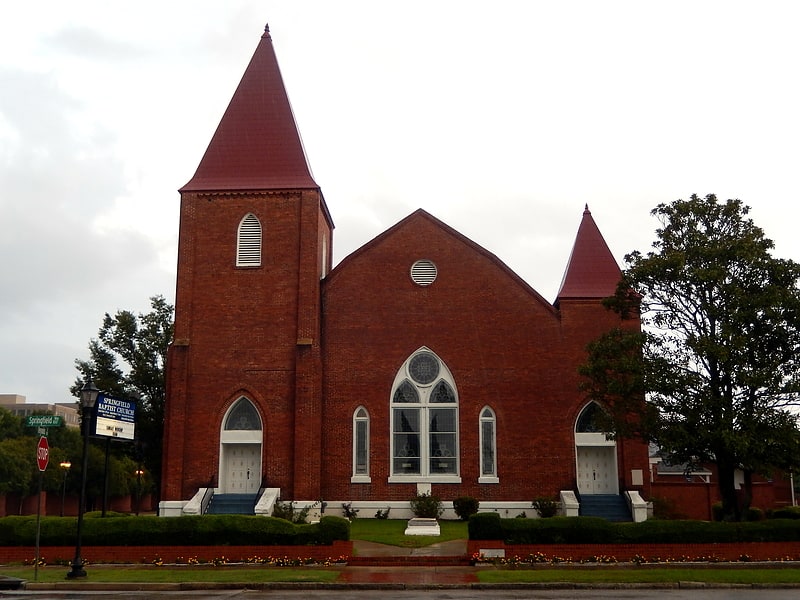
Baptist church in Augusta, Georgia. Springfield Baptist Church in Augusta, Georgia was built in 1801 and is a significant historical building for its architecture, religious history, and African American heritage. The congregation initially had a wood structure built and used by the Saint John Methodist Church. Since 1944, this building has been home to the Springfield Baptist congregation.
It was built in the architectural style of a New England meetinghouse, which is rare in Georgia. It is the oldest church building extant in Augusta and is claimed to be one of the oldest Black congregations in the U.S. The 1801, Springfield Baptist Church was listed on the National Register of Historic Places listings in Richmond County, Georgia in 1982, and the boundary of the National Register of Historic Places-listed site was increased in 1990.[17]
Address: 114 12th St, Augusta, GA 30901, 30901 Augusta (Old City)
Signers Monument

Park in Augusta, Georgia. Signers Monument is a granite obelisk located in Augusta, Georgia, on Greene Street. Signers Monument recognizes Georgia's three signatories of the United States Declaration of Independence: George Walton, Lyman Hall, and Button Gwinnett.[18]
Old Government House
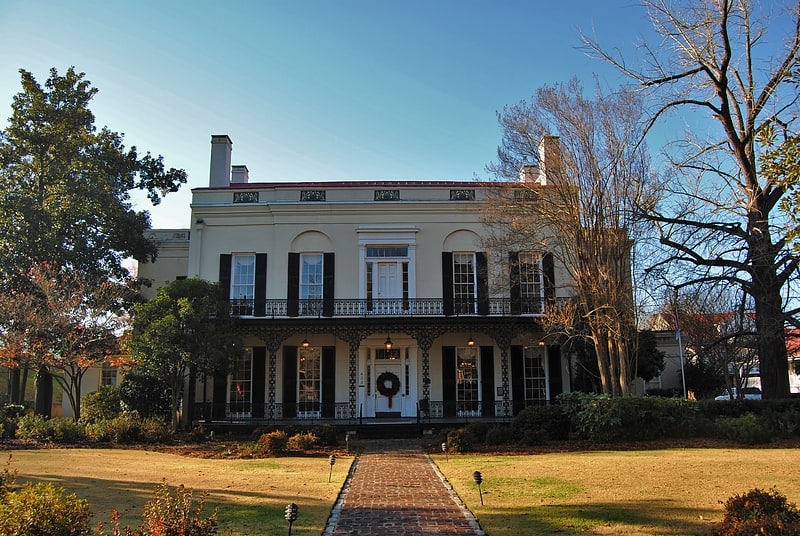
Courthouse. The Old Government House, also known as the Old Richmond County Courthouse, is a historic courthouse located in downtown Augusta, Georgia. It housed the seat of the local government from 1801 to 1821. It is one of the oldest remaining public buildings in the city.
It was built as a courthouse in 1801 and was expanded later when it served as a private residence.[19]
Address: 432 Telfair St, Augusta (Old City)
Phinizy Swamp Nature Park
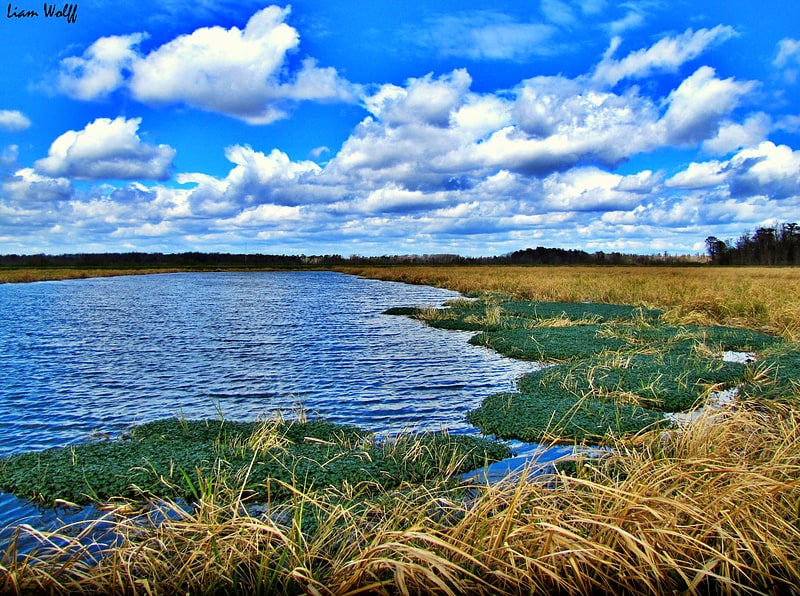
Park in Augusta, Georgia. Phinizy Swamp Nature Park is a 1,100-acre nature park in Augusta, Georgia. The park contains wetlands and woodlands and has a campus for water research and environmental education, which includes a visitor center. It has many bald cypresses draped in Spanish moss and forests of loblolly trees. Birds commonly found at Phinizy Swamp include: red-shouldered hawks, great blue herons, sora, wood ducks and bald eagles. Sometimes the park yields rarities for Georgia, including black-bellied whistling ducks, and a cave swallow, in 2004. Other wildlife commonly found in the park include frogs and toads; snakes, including water moccasin, pigmy rattlesnake, and copperhead; beavers and muskrat; turtles; and dragonflies. Fishing and hunting are not permitted within the park. Phinizy Swamp Nature Park is managed by Phinizy Center for Water Sciences.[20]